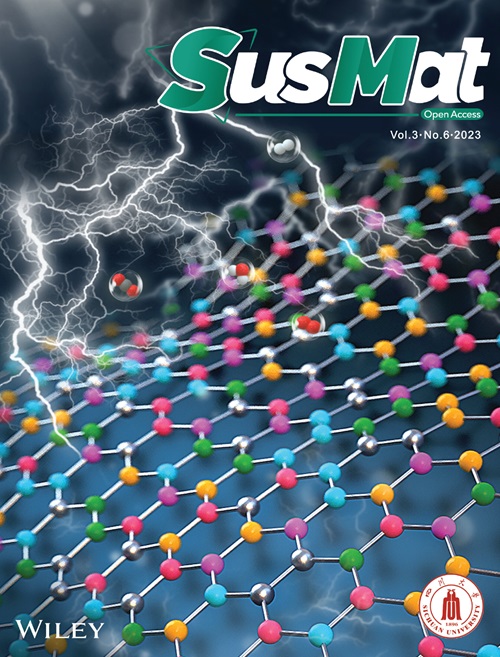熔体热解的最新进展:丰富来源的高价值碳材料的制备和应用
IF 18.7
1区 材料科学
Q1 CHEMISTRY, MULTIDISCIPLINARY
引用次数: 0
摘要
对复杂碳产品(包括炭黑、碳纳米管和石墨烯)不断增长的需求,尚未通过大规模、高效和可控的碳材料合成的传统技术得到充分解决。熔融热解成为生产这种高价值碳材料的有利策略。丰富的碳源包括甲烷(ch4)、二氧化碳(CO 2)、生物质和塑料可以在熔融金属或盐介质中热分解成碳成分。这种方法不仅消除了对传统化石燃料的依赖,而且还可以通过改变熔融介质来调节碳材料的形态,从而为有效和可控的碳材料制造提供了巨大的潜力。在这篇综述中,我们研究了熔融热解生产高价值碳材料的能力,这些材料来自甲烷、二氧化碳、生物质和塑料。同时,我们详细概述了这种新方法的潜在应用,特别强调了它在超级电容器、柔性材料和电化学电池领域的相关性。此外,我们展望了熔融热解的未来发展轨迹,强调了与辅助工艺或技术(如可再生能源系统和碳捕获和储存)的融合,这是一条非常有希望继续研究的道路。本文章由计算机程序翻译,如有差异,请以英文原文为准。
Recent progress in melt pyrolysis: Fabrication and applications of high‐value carbon materials from abundant sources
Abstract The escalating demand for sophisticated carbon products, including carbon black, carbon nanotubes (CNTs), and graphene, has yet to be adequately addressed by conventional techniques with respect to large‐scale, efficient, and controllable carbon material synthesis. Molten pyrolysis emerges as a propitious strategy for generating such high‐value carbon materials. Abundant carbon sources encompassing methane (CH 4 ), carbon dioxide (CO 2 ), biomass, and plastics can undergo thermal decomposition into carbon constituents within molten metal or salt media. This methodology not only obviates dependence on traditional fossil fuels but additionally enables modulation of carbon material morphologies by varying the molten media, thereby presenting substantial potential for effective and controlled carbon material fabrication. In this review, we examine the capacity of molten pyrolysis in producing high‐value carbon materials derived from CH 4 , CO 2 , biomass, and plastics. Concurrently, we present a detailed overview of the potential applications of this novel methodology, particularly emphasizing its relevance in the fields of supercapacitors, flexible materials, and electrochemical cells. Furthermore, we contemplate future trajectories for molten pyrolysis, accentuating that amalgamation with auxiliary processes or technologies—like renewable energy systems and carbon capture and storage—represents a remarkably promising route for continued investigation.
求助全文
通过发布文献求助,成功后即可免费获取论文全文。
去求助
来源期刊
自引率
4.20%
发文量
0
期刊介绍:
SusMat aims to publish interdisciplinary and balanced research on sustainable development in various areas including materials science, engineering, chemistry, physics, and ecology. The journal focuses on sustainable materials and their impact on energy and the environment. The topics covered include environment-friendly materials, green catalysis, clean energy, and waste treatment and management. The readership includes materials scientists, engineers, chemists, physicists, energy and environment researchers, and policy makers. The journal is indexed in CAS, Current Contents, DOAJ, Science Citation Index Expanded, and Web of Science. The journal highly values innovative multidisciplinary research with wide impact.

 求助内容:
求助内容: 应助结果提醒方式:
应助结果提醒方式:


